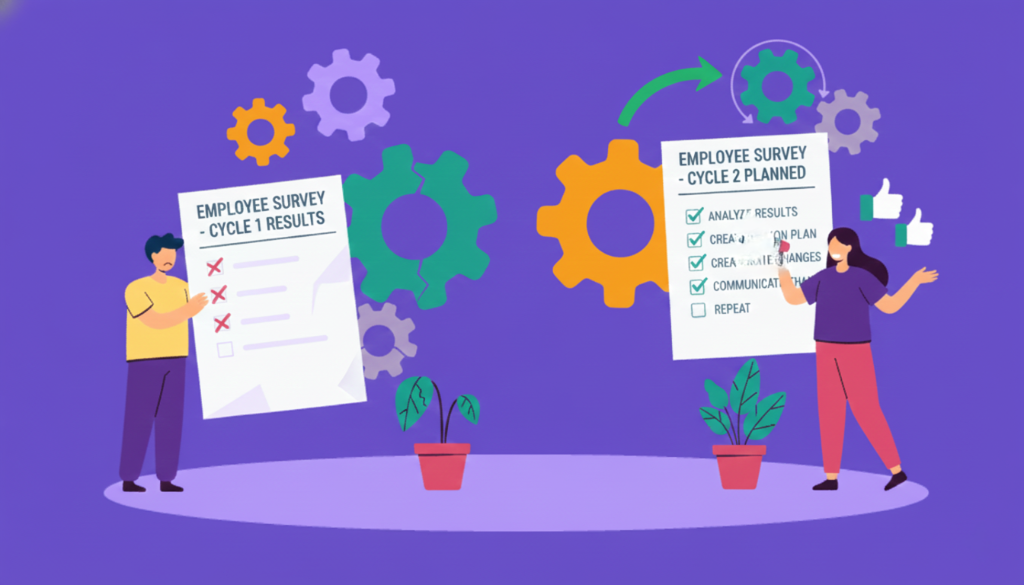50 Employee Survey Questions About Work Environment You Can Use Today

A Global Employee Recognition and Wellness Platform
Nearly 45% of employees would consider quitting if forced into full on-site work without flexibility. That's your workforce right now, quietly evaluating whether your workplace is worth staying for.
The problem is: most employee surveys ask "Are you satisfied with your job?" and wonder why they can't predict turnover. Meanwhile, a 2022 study from meQuilibrium of around 4,000 workers found that on-site employees were 66% more likely to say mistakes are held against them and 57% more likely to feel rejected for being different.
Your work environment, not your perks, drives retention.
This guide gives you 50 research-backed survey questions that reveal what employees actually think about psychological safety, manager support, workload balance, and belonging. Questions organized into 7 key areas that determine whether people stay or leave.
Key Takeaways
- What Makes a Good Question for Work Environment Survey?
- Key Areas / Themes of Work Environment to Ask About
- 50 Employee Survey Questions About Work Environment
- Tips for Designing/Implementing the Survey
What Makes a Good Question for Work Environment Survey?
Designing the right questions matters as much as deciding the themes. Poorly written items produce polite but meaningless answers; well-crafted ones reveal signals leaders can act on. A good work-environment question is clear, neutral, and measurable. It doesn’t push employees toward a “right” answer, and it produces data you can trend over time without losing nuance.
Key principles:
-
Clarity: Keep it simple, one idea per item, no jargon.
-
Neutral wording: Don’t load the phrasing. For example, ask “I have the tools I need to do my job well” instead of “Our excellent tools help me excel.”
-
Scaled responses: Use consistent 5- or 7-point Likert scales to enable tracking and comparisons.
-
Balanced phrasing: Mix positively and negatively worded items to reduce response bias.
-
Quantitative + qualitative pairing: After a scale item, add a focused open-ended prompt (e.g., “What tool most slows you down?”).
-
Cultural/regional sensitivity: Adapt labels (supervisor, line lead, manager) and avoid idioms that may not translate.
Do Give a Read: 15 Employee-Centric Culture Survey Questions
7 Key Areas / Themes of Work Environment to Ask About

Every work environment survey should cover a consistent set of themes. Together, they provide a holistic picture of what supports or undermines performance. Below, each theme includes three practical question types: a power question (a high-leverage scale item), a follow-up (an open question that adds context), and a trend question (a scale item to track over time).
1. Physical Workspace, Amenities, and Safety
A safe, ergonomic, and well-equipped environment is foundational. Even in hybrid models, employees evaluate whether their space helps or hinders them.
- Power question: I have a safe, ergonomic workspace (whether on-site or remote) that allows me to perform at my best.
- Follow-up: What one change to your physical workspace or safety processes would help you most?
- Trend question: Our organization consistently addresses safety issues and hazards in a timely way.
Why it matters: In 2023, U.S. private‑industry employers reported 2.6 million nonfatal workplace injuries and illnesses. Employees who feel unsafe disengage quickly. Safety is also strongly tied to trust, when hazards are ignored, workers assume leadership will ignore other concerns too.
Recommended Read: Practical Tips For Improving Workplace Safety
2. Psychological Safety, Inclusion, and Voice
Without psychological safety, employees are less likely to speak up or take risks, stalling innovation and collaboration.
- Power question: I feel safe raising concerns or admitting mistakes without negative consequences.
- Follow-up: If you’ve ever held back an idea or concern, what made you hesitate?
- Trend question: Team discussions encourage thoughtful disagreement and learning.
Why it matters: According to the 2024 Work in America report by the APA, employees in environments with high psychological safety report vastly better well‑being and lower burnout levels. In contrast, low psychological safety is linked to higher turnover intention and disengagement.
3. Workload, Work‑Life Balance, and Flexibility
Workload balance is a key driver of well‑being. When employees feel overburdened, engagement plummets, and burnout accelerates.
- Power question: My workload is manageable within my regular working hours.
- Follow-up: What recurring task or policy most disrupts your balance between work and personal life?
- Trend question: I have enough flexibility in where and when I work to be effective.
Why it matters: A 2024 FlexJobs survey found that 70% of workers ranked flexibility as their top priority in job satisfaction. Employees with poor work‑life balance are twice as likely to leave within a year. Overwork and lack of flexibility contribute to burnout, absenteeism, and turnover.
4. Manager–Team Relationships and Support
Managers are critical to setting the tone of the work environment. Clear expectations and strong support can improve engagement and performance.
- Power question: My manager sets clear expectations and supports my success.
- Follow-up: What one thing your manager could do would make your work environment more supportive?
- Trend question: I receive regular, useful feedback that helps me improve.
Why it matters: Gallup’s report finds that managers account for 70% of variance in team engagement. Poor manager support drives disengagement and dissatisfaction faster than any other factor.
Recommended Read: How to spot and deal with a bad manager?
5. Resources, Tools, and Infrastructure
The right resources, systems, and technology enable employees to perform at their best. Lack of access to the right tools creates frustration and reduces productivity.
- Power question: I have the tools, data access, and systems I need to do my job well, wherever I’m working from.
- Follow-up: Which tool or system most frequently causes frustration or delays?
- Trend question: Our technology and infrastructure reliability meet the needs of my work.
Why it matters: Without the right technology, knowledge workers waste roughly 2.7 hours per week on workarounds and digital friction. Equip them with proper tools, clean access, and reliable systems to recover that time.
6. Culture, Belonging, and Respect
A culture of belonging fosters trust, enhances teamwork, and improves retention. Employees who feel respected are more likely to engage and stay with the company.
- Power question: People in this organization treat each other with respect, regardless of role or background.
- Follow-up: Describe a moment when you felt truly included or excluded at work.
- Trend question: I feel like I belong on this team.
Why it matters: Employees who feel they truly belong are 4–8x more likely to remain with their organization.
7. Well‑Being and Wellness
Well-being is integral to sustainable performance. Employees who feel mentally and physically well perform better and stay engaged longer.
- Power question: My work environment supports my mental and physical well‑being.
- Follow-up: What policy or practice would most improve your well-being at work?
- Trend question: I have access to resources that help me maintain my well-being.
Why it matters: Gallup reports that poor mental health shows up fast in capacity. Workers with fair or poor mental health report 12 unplanned absence days a year (vs 2.5 for others). At a global level, depression and anxiety drive 12 billion working days lost annually, around US $1 trillion in lost productivity. Investing in effective well-being programs helps reduce burnout drivers and recover time-on-task.
50 Employee Survey Questions About Work Environment

You don’t learn much from asking, “Are you happy at work?” A good survey digs deeper. That’s why this set mixes Likert scales (to spot patterns), open-ended prompts (to hear real voices), and a few multiple-choice questions (to get quick, actionable insights). Together, they’ll tell you not just what employees feel, but why and what you can actually do about it.
Likert scale (30 Questions)
-
I have a safe, ergonomic workspace that supports my productivity.
-
The lighting, temperature, and noise levels in my workspace help me work effectively.
-
Safety concerns are addressed promptly in this organization.
-
I feel comfortable sharing new ideas with my colleagues.
-
I can admit mistakes without fear of negative consequences.
-
My perspectives are respected regardless of role or background.
-
Team discussions encourage open and constructive disagreement.
-
I believe leaders genuinely value employee input.
-
My workload is manageable within my regular working hours.
-
I can disconnect from work outside normal hours without guilt.
-
I have enough flexibility in when and where I work.
-
Workload distribution is fair across my team.
-
My manager sets clear expectations for my role.
-
I receive regular, useful feedback from my manager.
-
My manager supports me when I face challenges.
-
I trust my manager to act in my best interests.
-
My manager communicates openly and transparently.
-
I have access to the tools and systems I need to do my job.
-
The technology I use is reliable and rarely disrupts my work.
-
IT support resolves issues quickly.
-
Our tools support both on-site and remote employees equally well.
-
The company invests in the right technology to enable productivity.
-
People here treat each other with respect.
-
I feel a strong sense of belonging on my team.
-
Employees of all backgrounds have equal opportunities here.
-
Our company culture promotes fairness and inclusion.
-
Leadership models the values they expect from employees.
-
My work environment supports my mental well-being.
-
My work environment supports my physical well-being.
-
Overall, my work environment enables me to do my best work.
Open-Ended (10 Questions)
-
What one improvement to your workspace would make the biggest difference?
-
Describe a time when you felt unsafe or unsupported at work.
-
What makes it easier—or harder—for you to speak up at work?
-
Can you recall a time when you felt truly heard at work?
-
What one change would most improve your work-life balance?
-
How does workload affect your motivation and engagement?
-
What’s one thing your manager could do differently to support you?
-
Which tool or system frustrates you the most, and why?
-
What aspect of our culture makes you proudest to work here?
-
What program or policy would most improve your well-being?
Multiple-Choice (10 Questions)
-
Which safety resource do you rely on most? (Training, Equipment, Reporting system, None)
-
Which channel feels safest to raise concerns? (Manager 1:1s, HR, Anonymous survey, Team meetings)
-
What’s the biggest cause of workload pressure? (Staffing, Priorities, Tools, Leadership expectations)
-
Which flexibility option would you value most? (Remote days, Flexible hours, Compressed week, Job share)
-
Which manager behavior do you need most right now? (Feedback, Recognition, Clear goals, Coaching)
-
Which type of tool would improve your work most? (Collaboration platform, Hardware, Data access, Workflow automation)
-
Where do you see the biggest cultural gap? (Respect, Inclusion, Recognition, Transparency)
-
Which wellness resource do you value most? (Counseling, Fitness stipend, Wellness app, None)
-
Which form of recognition motivates you most? (Public, Private, Peer-to-peer, Manager-led)
-
Which company communication channel do you find most effective? (Email, Slack/Teams, Town halls, Intranet)
Tips for Designing/Implementing the Survey
- Keep surveys short and focused, like a pulse survey.
- Mix Likert, open-ended, and MCQs for balanced insights.
- Use consistent scales (e.g., 5-point or 7-point) for comparability.
- Assure anonymity to encourage honesty.
- Pilot-test questions before rolling out company-wide.
- Avoid survey fatigue, don’t overload employees with too many surveys.
- Time surveys away from peak work or holiday periods.
- Communicate the purpose clearly to employees before launch.
- Share key results and actions afterward to build trust.
- Rotate some questions to track trends while keeping the survey fresh.
End Note
The right survey questions reveal what employees actually need: safety, trust, balance, tools, support, and well-being. When you ask with clarity, act on the results, and keep the loop open, surveys stop being “HR admin work” and become a real driver of engagement and retention.
Start small with pulse checks, build trust with transparency, and scale up, your employees will tell you exactly how to create an environment where they can thrive.
FAQs
Q1. What are examples of work environment survey questions?
Examples include: “I feel comfortable raising concerns without fear of negative consequences” (Likert), “What one change would most improve your work-life balance?” (Open-ended), and “Which channel feels safest to raise concerns?” (MCQ). The right mix of formats ensures both measurable data and actionable insights.
Q2. How many questions should a work environment survey have?
It depends on the purpose. A pulse survey should stay short (10–12 questions). A quarterly check-in might run 20–25 questions. A full annual audit can extend to 50 questions if employees are given enough time and clear communication about why it matters.
Q3. How often should you survey employees about their work environment?
Best practice is to use quarterly pulse surveys for timely feedback and one annual deep-dive survey to track long-term progress. The key is to act on the results consistently, asking questions without follow-up creates distrust.

















